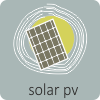![Source: Rfassbind (Own work.) [Public domain], via Wikimedia Commons](/wp-content/uploads/2015/10/From_a_solar_cell_to_a_PV_system.svg_.png)
Components of a Typical Solar PhotoVoltaic System
Solar photovoltaics are a combination of panels containing a number of solar cells which convert the incident solar energy into usable electricity. These panels can be placed at any place which receives abundant amount of sunlight. The solar cells are made up of semiconductor materials, such as crystalline silicon, which includes monocrystalline silicon, polycrystalline silicon, ribbon silicon and mono-like-multi silicon, and thin films, which include cadmium telluride, copper indium gallium selenide, silicon thin film and gallium arsenide thin film. The broad difference between the two technologies is that the former consists of slices of solar-grade silicon assembled together whereas the latter consists of thin layers of semi-conductors deposited in cheap materials like glass, polymer, or metal.
The process of generation of electricity from solar cells is a two – step process. The first step is the physical process and involves the photoelectric effect in which the photons strike the metal surface and provide energy to the electrons in the metal. The next step involves the electrochemical process in which the excited electrons are arranged in a series, thereby creating an electric voltage and generating electric current. The generated electricity can either be consumed instantaneously on site, stored in batteries for later use, or sold to power utilities according to local government regulations and prevalent tariffs.
Solar Energy Deployment
Based on the availability of space and capital, solar energy can either be generated offsite at utility level, or onsite at small scale. Both types of generation mechanisms are guided by their own rules and policy frameworks.
- Utility driven solar project development – These are large scale centralized solar power plants which generate electricity to be sold to power utilities. These plants require large tracts of land and considerable capital. These plants usually have a long term Power Purchase Agreement (PPA) with the power utility and usually serve to fulfil their Renewable Purchase Obligations (RPO).
- Customer driven solar project development – These are small scale decentralized solar power plants installed by electricity consumers in their own premises. These type of projects require less area and capital investment. These systems are further divided into two parts:
- Grid Connected Systems – Grid connected PV systems are designed to work in conjunction with the utility grid. Such systems can either supply the complete generated electricity to the grid or can use the electricity for building use and supply only the excess power to the grid.
- Stand – alone systems – Stand – alone PV systems are designed to operate within the context of the building and are not connected to the grid. The electricity generated is consumed by the building and excess energy generated can be stored in the batteries for future use.
Solar electricity generation system
A complete solar electricity generation system consists of components to produce electricity, convert generated DC into AC that can be used by equipment installed in the building, and store excess generated electricity (for those systems which do not intend to sell excess generated electricity to grid).
- Solar PV panels – Solar panels are the basic part of a solar electricity generation system. These panels consist of numerous solar cells which are made up of a semiconducting material. These solar cells are responsible for conversion of incident light into usable electricity. Although the sizes may vary according to generation capacity, location and budget, the typical length of the solar panel ranges between 65 inches and 77 inches and the breadth ranges between 35 inches and 39 inches. The typical depth of solar panels ranges from 1.4 inches to 1.8 inches.
- Inverter – The inverter converts the DC produced by the solar panels into AC that can be fed into the grid or used for the operation of electrical appliances. Additionally, the inverter acts as a safety valve between the PV system and the electricity mains.
- Storage Batteries – Storage batteries are used to store excess electric energy generated by the PV system for future use. Batteries are typically employed in PV systems which do not intend to sell excess electricity to power utilities.
- Electricity Meter – The meter counts the number of units of electricity generated by the PV system. They are essential for calculating the proceeds from the sale of electricity to the grid.
Factors affecting generation of electricity
Solar cell efficiency is the ratio of electrical output to the incident solar energy. Major factors efficiency of solar cells are:
- Location, tilt, and orientation – The incident solar radiation varies significantly with longitude and orientation. Within a particular longitude and orientation, maximum solar radiation is available in a particular tilt angle based on sun path.
- Over shading – Site characteristics like geography, neighbouring buildings, self-shading, cloud factors etc. affect the useful solar radiation falling on the PV panels. System design should be done to minimize panel area affected by shading.
- Temperature – An increase in panel temperature due to solar radiation can affect the PV module performance especially in crystalline silicon modules. It is estimated that for every 1 0C increase in ambient temperature above 25 0C, the PV module performance decreases in the range of 0.4 – 0.5%. Special considerations are given to design air flow over the backs of the PV modules to avoid higher temperature by excessive heat gains.
- Panel efficiency – Panel efficiency is an estimate of successful conversion of incident solar radiation to electric energy. Panel efficiency depends on PV module technology, manufacturing techniques, and system design. A crystalline silicon based module has an efficiency in the range of 12-14% where as a thin film based module has an efficiency in the range of 10 – 11%.












